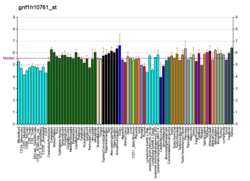MAFA (gene)
| MAFA | |||||||||||||||||||||||||
|---|---|---|---|---|---|---|---|---|---|---|---|---|---|---|---|---|---|---|---|---|---|---|---|---|---|
| |||||||||||||||||||||||||
| Identifiers | |||||||||||||||||||||||||
| Aliases | MAFA, RIPE3b1, hMafA, MAF bZIP transcription factor A, INSDM | ||||||||||||||||||||||||
| External IDs | MGI: 2673307 HomoloGene: 65867 GeneCards: MAFA | ||||||||||||||||||||||||
| |||||||||||||||||||||||||
| |||||||||||||||||||||||||
| |||||||||||||||||||||||||
| |||||||||||||||||||||||||
| Orthologs | |||||||||||||||||||||||||
| Species | Human | Mouse | |||||||||||||||||||||||
| Entrez |
|
| |||||||||||||||||||||||
| Ensembl |
|
| |||||||||||||||||||||||
| UniProt |
|
| |||||||||||||||||||||||
| RefSeq (mRNA) |
|
| |||||||||||||||||||||||
| RefSeq (protein) |
|
| |||||||||||||||||||||||
| Location (UCSC) | Chr 8: 143.42 – 143.43 Mb | Chr 15: 75.75 – 75.75 Mb | |||||||||||||||||||||||
PubMed search | [3] | [4] | |||||||||||||||||||||||
| Wikidata | |||||||||||||||||||||||||
| |||||||||||||||||||||||||
Transcription factor MafA is a protein that in humans is encoded by the MAFA gene.[5] It is a member of the Maf family of transcription factors.[6]
Contents
1 MAFA assists in insulin regulation
2 Interactions
3 References
4 Further reading
MAFA assists in insulin regulation
An in vivo study on mice proved MafA binds to the promoter in an insulin gene to regulate insulin transcription in response to serum glucose levels.[7] MafA is a β cell-specific activator, which differentiates it from other transcription factors involved with insulin gene expression.[8] It helps regulate the β cells involved with insulin secretion primarily by maintaining β cell metabolism.[9] The amount of MafA in the β cells is regulated by levels of glucose and oxidative stress.[6]
Interactions
MafA (gene) has been shown to interact with NEUROD1[10] and Pdx1.[10] MafA works with Pdx1 to activate the insulin gene.[6]
References
^ abc GRCh38: Ensembl release 89: ENSG00000182759 - Ensembl, May 2017
^ abc GRCm38: Ensembl release 89: ENSMUSG00000047591 - Ensembl, May 2017
^ "Human PubMed Reference:"..mw-parser-output cite.citation{font-style:inherit}.mw-parser-output .citation q{quotes:"""""""'""'"}.mw-parser-output .citation .cs1-lock-free a{background:url("//upload.wikimedia.org/wikipedia/commons/thumb/6/65/Lock-green.svg/9px-Lock-green.svg.png")no-repeat;background-position:right .1em center}.mw-parser-output .citation .cs1-lock-limited a,.mw-parser-output .citation .cs1-lock-registration a{background:url("//upload.wikimedia.org/wikipedia/commons/thumb/d/d6/Lock-gray-alt-2.svg/9px-Lock-gray-alt-2.svg.png")no-repeat;background-position:right .1em center}.mw-parser-output .citation .cs1-lock-subscription a{background:url("//upload.wikimedia.org/wikipedia/commons/thumb/a/aa/Lock-red-alt-2.svg/9px-Lock-red-alt-2.svg.png")no-repeat;background-position:right .1em center}.mw-parser-output .cs1-subscription,.mw-parser-output .cs1-registration{color:#555}.mw-parser-output .cs1-subscription span,.mw-parser-output .cs1-registration span{border-bottom:1px dotted;cursor:help}.mw-parser-output .cs1-ws-icon a{background:url("//upload.wikimedia.org/wikipedia/commons/thumb/4/4c/Wikisource-logo.svg/12px-Wikisource-logo.svg.png")no-repeat;background-position:right .1em center}.mw-parser-output code.cs1-code{color:inherit;background:inherit;border:inherit;padding:inherit}.mw-parser-output .cs1-hidden-error{display:none;font-size:100%}.mw-parser-output .cs1-visible-error{font-size:100%}.mw-parser-output .cs1-maint{display:none;color:#33aa33;margin-left:0.3em}.mw-parser-output .cs1-subscription,.mw-parser-output .cs1-registration,.mw-parser-output .cs1-format{font-size:95%}.mw-parser-output .cs1-kern-left,.mw-parser-output .cs1-kern-wl-left{padding-left:0.2em}.mw-parser-output .cs1-kern-right,.mw-parser-output .cs1-kern-wl-right{padding-right:0.2em}
^ "Mouse PubMed Reference:".
^ "Entrez Gene: MAFA v-maf musculoaponeurotic fibrosarcoma oncogene homolog A (avian)".
^ abc Aramata; Han (2007). "Roles and Regulation of Transcription Factor MafA in Islet β-cells". Endocr. J. 54 (5): 659–66. doi:10.1507/endocrj.kr-101. PMID 17785922.
^ Zhang; Moriguchi (2005). "MafA Is a Key Regulator of Glucose-Stimulated Insulin Secretion". Mol. Cell. Biol. 25 (12): 4969–4976. doi:10.1128/MCB.25.12.4969-4976.2005. PMC 1140590. PMID 15923615.
^ Matsuoka; Artner (March 2004). "The MafA transcription factor appears to be responsible for tissue-specific expression of insulin". Proc. Natl. Acad. Sci. U.S.A. 101 (9): 2930–3. Bibcode:2004PNAS..101.2930M. doi:10.1073/pnas.0306233101. PMC 365722. PMID 14973194.
^ Wang; Kataoka (2007). "MAFA controls genes implicated in insulin biosynthesis and secretion". Diabetologia. 50 (2): 348–58. doi:10.1007/s00125-006-0490-2. PMC 2196442. PMID 17149590.
^ ab Zhao, Li; Guo Min; Matsuoka Taka-Aki; Hagman Derek K; Parazzoli Susan D; Poitout Vincent; Stein Roland (Mar 2005). "The islet beta cell-enriched MafA activator is a key regulator of insulin gene transcription". J. Biol. Chem. 280 (12): 11887–94. doi:10.1074/jbc.M409475200. ISSN 0021-9258. PMID 15665000.
Further reading
.mw-parser-output .refbegin{font-size:90%;margin-bottom:0.5em}.mw-parser-output .refbegin-hanging-indents>ul{list-style-type:none;margin-left:0}.mw-parser-output .refbegin-hanging-indents>ul>li,.mw-parser-output .refbegin-hanging-indents>dl>dd{margin-left:0;padding-left:3.2em;text-indent:-3.2em;list-style:none}.mw-parser-output .refbegin-100{font-size:100%}
Benkhelifa S, Provot S, Nabais E, et al. (2001). "Phosphorylation of MafA is essential for its transcriptional and biological properties". Mol. Cell. Biol. 21 (14): 4441–52. doi:10.1128/MCB.21.14.4441-4452.2001. PMC 87104. PMID 11416124.
Olbrot M, Rud J, Moss LG, Sharma A (2002). "Identification of beta-cell-specific insulin gene transcription factor RIPE3b1 as mammalian MafA". Proc. Natl. Acad. Sci. U.S.A. 99 (10): 6737–42. Bibcode:2002PNAS...99.6737O. doi:10.1073/pnas.102168499. PMC 124472. PMID 12011435.
Kataoka K, Han SI, Shioda S, et al. (2003). "MafA is a glucose-regulated and pancreatic beta-cell-specific transcriptional activator for the insulin gene". J. Biol. Chem. 277 (51): 49903–10. doi:10.1074/jbc.M206796200. PMID 12368292.
Matsuoka TA, Artner I, Henderson E, et al. (2004). "The MafA transcription factor appears to be responsible for tissue-specific expression of insulin". Proc. Natl. Acad. Sci. U.S.A. 101 (9): 2930–3. Bibcode:2004PNAS..101.2930M. doi:10.1073/pnas.0306233101. PMC 365722. PMID 14973194.
Kaneto H, Matsuoka TA, Nakatani Y, et al. (2005). "A crucial role of MafA as a novel therapeutic target for diabetes". J. Biol. Chem. 280 (15): 15047–52. doi:10.1074/jbc.M412013200. PMID 15664997.
Harmon JS, Stein R, Robertson RP (2005). "Oxidative stress-mediated, post-translational loss of MafA protein as a contributing mechanism to loss of insulin gene expression in glucotoxic beta cells". J. Biol. Chem. 280 (12): 11107–13. doi:10.1074/jbc.M410345200. PMID 15664999.
Zhao L, Guo M, Matsuoka TA, et al. (2005). "The islet beta cell-enriched MafA activator is a key regulator of insulin gene transcription". J. Biol. Chem. 280 (12): 11887–94. doi:10.1074/jbc.M409475200. PMID 15665000.
Aramata S, Han SI, Yasuda K, Kataoka K (2005). "Synergistic activation of the insulin gene promoter by the beta-cell enriched transcription factors MafA, Beta2, and Pdx1". Biochim. Biophys. Acta. 1730 (1): 41–6. doi:10.1016/j.bbaexp.2005.05.009. PMID 15993959.
Raum JC, Gerrish K, Artner I, et al. (2006). "FoxA2, Nkx2.2, and PDX-1 regulate islet beta-cell-specific mafA expression through conserved sequences located between base pairs -8118 and -7750 upstream from the transcription start site". Mol. Cell. Biol. 26 (15): 5735–43. doi:10.1128/MCB.00249-06. PMC 1592775. PMID 16847327.
This article on a gene on human chromosome 8 is a stub. You can help Wikipedia by expanding it. |




